Review: 2014 Nissan Versa Note (With Video)

Making a “cheap” car is a tried and true formula for most auto makers. Making a car with a low sticker and a solid value proposition is tough. Not only do you have to keep the starting price low, but you have to worry about fuel economy, maintenance, insurance and everything that goes into an ownership experience. Reviewing cars that focus heavily on value is even trickier. Indeed a number of buff-book journalists were offended by the Versa Sedan’s plastics, lack of features and small engine. My response was simple: what do you expect of the cheapest car in America? Trouble is, the Versa Note isn’t the cheapest hatchback in America, so this review is about that elusive quality: value.
Exterior
Let’s be frank, the last Versa hatchback to grace our shores was strange looking. This is because Nissan sent us the Japanese market “Tiida” hatchback, while Europeans got the related, but more attractive, Nissan Note. 2014 brings a change, with Nissan aligning America with the redesigned Note from Europe. Meanwhile China and other countries get a redesigned Tiida. (Check out the picture below.) Nissan decided that there was value in the Versa brand so the final product was dubbed the “Versa Note.”
I must admit that the product shuffle strikes me as a mixed bag. While the outgoing Versa hatch was undeniably dowdy, I find the new Tiida (above) downright sexy for a small car. The Versa Note? “Note” so much. Nissan tells us the Note is all about practicality, and the math is simple: the squarer the hatch, the more stuff you can jam inside. Thankfully Nissan included a few swoopy door stampings to prevent any 1980s flashbacks, but the resulting design obviously prioritized function over form. At 66 inches wide and 60 inches tall, the Note looks doesn’t just look square from the side, but from the front and rear as well. Proportions like these are hard to avoid with a small hatchback but the Versa’s horizontal grille helps detract from it in a way that the Spark’s tall grille amplifies the effect. When it comes to looks, the Rio and the Fiesta win the beauty pageant.
While the Versa continues to hold the title of “least expensive car in America”, the Chevrolet Spark ($12,995), Smart ($13,240) and Mitsubishi Mirage ($13,790) and Kia Rio 5-door ($13,800) all ring in below the Note’s $13,990 starting price. For those of you counting, that’s a whopping $2,000 (or 17%) bump over the Versa sedan. I’m going to cross the Smart car off the list because it’s a two-seat hatch, and we can call the Mirage and Rio near ties in starting price, but the Spark is a decent $1,000 discount. Since this review is all about value at the bottom of the automotive food chain, I’m not going to cover the more expensive options in this segment.
Interior
Despite the price bump from the Versa Sedan, the Note’s interior is nearly identical. The same hard plastic dashboard, thin headliner and minimalist controls are all cast in the same shade of black. The only notable changes versus the sedan are a steering wheel lifted from the Sentra, and standard folding rear seats. Jumping up to the $15,990 SV trim buys you nicer seat and headliner fabric, but the rest of the interior remains the same. The discount interior is something that doesn’t bother me in the Versa sedan, but the Note is two-grand more. At this price the Rio is made from nicer materials for slightly less and the Fiesta’s classier cabin is a scant $110 more. Materials tie with the Chevy Spark which is great for the Chevy but not so good for the Nissan. Meanwhile the Mitsubishi looks dated both inside and out with the most discount cabin I have seen in a long time.
Base shoppers will find standard air conditioning, 60/40 folding rear seats and sun-visors that extend, but notably missing from the starting price are power windows, power door locks, vanity mirrors and rear cup holders. This is where I say: “what did you expect?” After all, the Spark and Rio don’t offer all the goodies in their base models either. Here comes that pesky “value” proposition again however: the Spark is cheaper so the lower level of equipment seems more appropriate. If that’s not enough of a value proposition, consider this, for $50 less than a base Versa you can get a Spark with all those missing features plus cruise control.
Nissan tells us the bulk of Note volume is the $15,990 SV model which adds a “2-speed CVT,” cruise control, armrest for the driver, leather wrapped steering wheel with audio controls, and some Bluetooth love. Trouble is, that Spark gives you all that and a 7-inch touchscreen nav system for less. $995 less to be exact.
Front seat comfort proved good around town, but I found the lack of lumbar support a problem on longer trips. Cushioning is firm but comfortable and the range of motion in the 6-way manual seats is average for this segment. Sadly Nissan doesn’t offer a telescoping steering wheel in the Note like many of the competitors do. I didn’t notice this problem with the Versa sedan, but the Note I had for a week suffered from a footwell that barely fit my size 11 shoes. If you have bigger feet you may have difficulty wedging your footwear in.
The big selling point for this sub-compact is, oddly enough, the back seat. Although sitting three abreast in the rear is a cozy affair due to the car’s width, rear leg room is simply amazing. You’ll find 7 inches more rear legroom than the Rio making it possible, and relatively comfortable, for a quartet of six-foot-five guys on a road trip. No other hatch even comes close to the Note’s rear seat numbers which are just 1/10th lower than a Jaguar XJ. Because the Spark is the narrowest of the group by several inches, it only has two seats in the rear. The Mirage claims to seat five, but if the Note is “cozy,” the narrower Mitsubishi is downright cramped. Thanks to the tall body, the Versa also delivers more headroom than the competition without the rear seats riding on the ground. Cargo volume grows 30% from the Versa sedan to 21 cubic feet behind the rear seats and 38 with the rear seats folded.
Infotainment
Base shoppers get a simple head unit with a CD-player, aux input and four speakers. Here again the Spark beats Nissan to the value game. The base Spark is just as basic, but for the same price as a base Note, Chevy sells you a 7-inch touchscreen, USB integration, 6 speakers, XM Satellite radio, smartphone integration with smartphone-based navigation and OnStar. Getting to this level of technology in the Note will set you back $18,140 and Nissan doesn’t have an OnStar alternative for the Note at any price.
The Note that Nissan lent me for a week was the fully-loaded SL model. This meant I had the NissanConnect system you see above along with an all-around camera system. This low-cost system, also found on Sentra and NV200, is one of my favorite systems on the market. The interface is simple, easy to navigate and intuitive. The latest software builds on their old “low-cost navigation” unit by adding streaming media, smartphone and Google data services. The touchscreen also integrates with the Note’s available around view camera which gives you a bird’s-eye view while parking. Although I found the low-res images lacked in detail, it did help keep the Note scratch-free in tricky parking situations. Now for the fly in the ointment. Nissan puts this head unit in an $800 bundle with the fancy camera system and requires that you also have the $540 package that includes rear seat cup holders and a two-stage load floor in the back. The total cost is $1,340 or a nearly 10% bump in MSRP.
Drivetrain
Like the sedan, the Note gets a 1.6L four-cylinder engine featuring variable valve timing and twin injectors per cylinder to deliver 109HP at 6,000 RPM and 107 lb-ft of twist at 4,400 RPM. This is a reduction of 13 horses compared to the 1.8L engine in the old Versa hatch which seems like a valid trade for improved efficiency. Base S models get a 5-speed manual, but if you want to make the most of the small engine, you’ll want Nissan’s CVT with a twist. The Versa CVT uses a two-speed planetary gearset after the CVT belt/cone unit. This extends the ratio spread to that of a conventional 7-speed auto. When starting out, the CVT is at its lowest ratio and the planetary is in “low.” Once the CVT reaches a high ratio, the planetary gearset switches to high allowing the CVT to reset to a lower ratio as you continue to accelerate. This improves low-end grunt, top-end fuel economy and allows the CVT to “downshift” faster than a traditional CVT by shifting the planetary gearset to “low” rather than adjusting the belt. Meanwhile the Spark and Mirage use a conventional “single range” CVT. (GM swapped out the old 4-speed for 2014.)
Thanks to a curb weight that is only 25 lbs heavier than the sedan (300lbs lighter than the 2012 hatch) and active grille shutters, fuel economy has jumped to a lofty 31/40/35 MPG (city/highway/combined) with the CVT and a less spectacular 27/36 with the manual. While 109 horsepower sounds less than exciting, consider that the Spark’s 1.2L engine delivers just 84 and the Mirage’s rough 3-cylinder is down another 10 ponies.
Drive
Thanks to a relatively long 102-inch wheelbase, the Note rides more like a mid-size sedan than the Spark or the Mirage. The difference is most notable out on the open highway where the Spark and Mirage “bob around” on washboard pavement. I wouldn’t describe the Note as “refined” in the general sense, but compared to the lower cost entries the Note holds its own. Even when compared with the Kia Rio and the Chevy Sonic, the Versa has a well-engineered feel out on the road. This is where I have to repeat: “keep your expectations priced at $13,990.”
Nissan decided to fit low rolling resistance tires to the Note which help bump fuel economy to a 35 MPG combined score. While the Note manages to out handle the Mirage, the Rio, Fiesta and Sonic whip the Note’s bottom on winding mountain roads. The Spark strikes a middle ground between the Rio and the Note. The electric power steering is accurate but numb. Acceleration is lazy but thanks to the deeper ratios in Nissan’s CVT it easily beats the Spark or the Mirage to highway speeds. Nissan spent considerable time injecting more sound insulating foam in every nook and cranny making this the quietest Versa ever at 70dB.
The Note managed a surprising 38.8 MPG during my 761 mile week with the “wee hatch,” as my neighbor called it. The high mileage numbers are largely thanks to the light curb weight, low rolling resistance tires and Nissan’s CVT which allows the Note’s tiny engine to barely spin at highway speeds. Although the Spark has the same EPA rating, I averaged 2 MPG less the last time I was in one. TTAC has yet to test a Mirage, so I’ll have to defer to the EPA’s 40 MPG average.
Being the cheap guy that I am, the more I cross-shopped the Note and the Spark, the less “value” I found in the little Nissan. The Note isn’t without its charms. The huge back seat and enormous cargo hold make it by far the most practical small hatch in America, the problem is all down to value. If you want sporty or luxury, buy the Fiesta but the best value in this compact segment is the Spark. It’s low $12,170 price tag rivals Nissan’s Versa sedan for the least expensive car but the $14,765 “1LT” with the manual is where the value is to be had. Priced several grand less than a comparable Note, the Spark beats Nissan at their own game. Minus one seat.
Nissan provided the vehicle, insurance and one tank of gas for this review
Specifications as tested
0-30: 3.39 Seconds
0-60: 9.13 Seconds
1/4 Mile: 17.08 Seconds @ 81.4 MPH
Average observed fuel economy: 38.8 MPG over 761 Miles
Cabin noise at 50 MPH: 70 dB

More by Alex L. Dykes
Latest Car Reviews
Read moreLatest Product Reviews
Read moreRecent Comments
- Lou_BC Actuality a very reasonable question.
- Lou_BC Peak rocket esthetic in those taillights (last photo)
- Lou_BC A pickup for most people would be a safe used car bet. Hard use/ abuse is relatively easy to spot and most people do not come close to using their full capabilities.
- Lorenzo People don't want EVs, they want inexpensive vehicles. EVs are not that. To paraphrase the philosopher Yogi Berra: If people don't wanna buy 'em, how you gonna stop 'em?
- Ras815 Ok, you weren't kidding. That rear pillar window trick is freakin' awesome. Even in 2024.



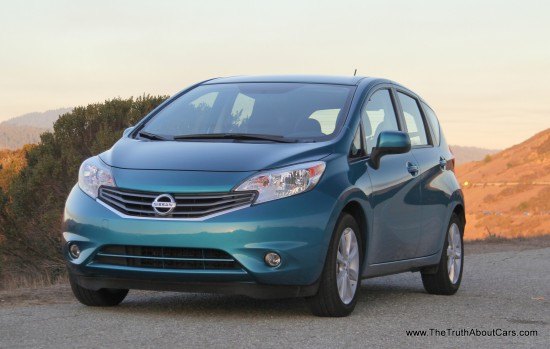









































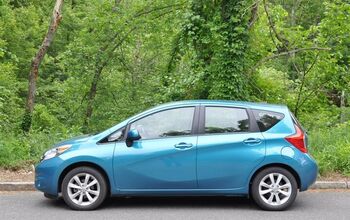
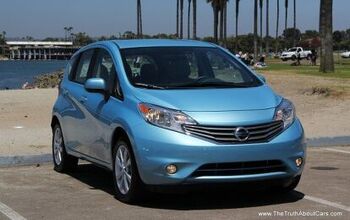
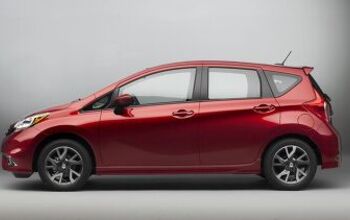
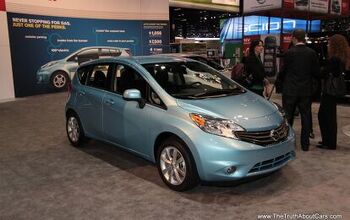











Comments
Join the conversation
I picked up a Versa rental yesterday. Every review of this car mentions the rear seat legroom. But what has gone unnoticed is lack of space in the front. I'm 6'3". Tall, but no Shaq. The drivers seat doesn't go anywhere near far enough back. At its rearmost position, my right leg is hitting my coffee cup. My left knee, with my foot on the dead pedal, is ABOVE the armrest/window switch panel. Yet there is tons of space left behind me. Inexcusable, and not a problem I've had in a Sonic or Fit.
5.6.2016 . Thanx for all the comments . . I came here because I was in San Bernardino last week and saw a Nissan billboard advertising new Verse' for $ 9,999.99 . . I wondered if any good and the comment here seem to bear that out for entry level basic transportation . . A tip 'o the pin to Sageev . . -Nate